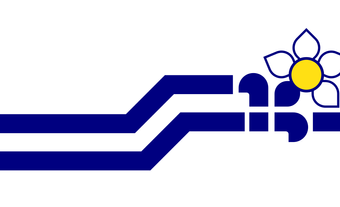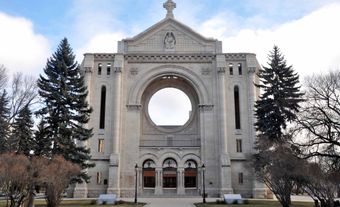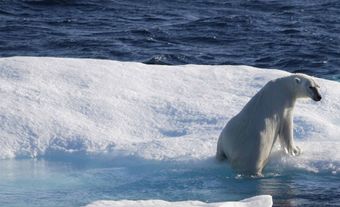History
French Canadian whaling crews sailed the region in the 19th century (see Whaling), Missionary Oblates first established Catholic missions and parishes there in 1910, then French Canadians spread the cooperative movement in all the Inuit towns to break the commercial monopoly held by the Hudson’s Bay Company.
The town of Frobisher Bay, later renamed Iqaluit (see Iqaluit), grew in the 1970s thanks to the growing presence of the Federal State and Bell Canada who employed Quebeckers, often on a short term basis. The latter founded the Association des francophones de Frobisher Bay (AFFB) in 1981 to combat seclusion. When Baffin Island’s main town became Iqaluit in 1987, the AFFB renamed itself the Association des francophones d’Iqaluit (AFI).
Nunavut was part of the Northwest Territories (NWT) until 1999. Although the NWT were overseen by the federal government, English had been the only official language of public affairs from the start. Then, in 1984, Yellowknife adopted the Official Languages Act, making English, French, Inuktitut and eight other Indigenous languages the official languages of the NWT (see Indigenous Languages in Canada). This was an opportunity for the AFI and the Fédération franco-ténoise (FFT) to claim French language services. While the FFT advocated for Francophones living across this immense territory covering 40% of Canadian soil, the AFFB/AFI managed local affairs.
In 1983, the AFFB obtained a license from the Canadian Radio-television and Telecommunications Commission (CRTC) to transmit the Radio-Canada television signal in Iqaluit. This is largely due to the Francophones’ desire to watch the Montreal Canadians and Québec Nordiques hockey games. The association also organized cultural events to mark the maple season, the lobster season, Saint-Jean-Baptiste Day and the Rendez-vous de la Francophonie. Under its new name Association des francophones d’Iqaluit (AFI), it erected a community centre in 1989, launched the community radio CFRT-FM in 1994 and established a consultation group.
Educational establishments
The AFFB demanded that French be taught to the 23 Francophone children enrolled in the Nakasuk School in Frobisher Bay. In 1984, Dennis Patterson, member of the Legislative Assembly for Iqaluit and Minister of Education of the NWT, convinced his colleagues to add half an hour of French lessons to the regular Anglophone curriculum. In 1990, the Supreme Court of Canada released the Mahé report which stipulated the right for Francophones to receive education in French. Only after this development did the NWT introduce the half-time program for French as a first language in the Nakasuk School, in September 1992. In September 1993, the curriculum for French as a first language was introduced from kindergarten to grade 6, but secondary school was still taught in English only.
The Nunavut territory, covering the same surface area as the NWT, was later created to offer Inuits a home where they would form the majority. This development monopolized the energies. In November 1997, the AFI and the Comité de parents francophones d’Iqaluit were dissolved to leave the way to the new Association des francophones du Nunavut (AFN), which would lay claim to educational rights more actively.
Nunavut recognized French as an official language from its establishment on 1 April 1999. That summer, a memorandum of understanding was signed regarding the construction of the first French language school, and the École des Trois-Soleil (ÉTS) was inaugurated in December 2001. This name refers to the parhelia which can be observed in the arctic sky in winter, but also to the harmony among Francophones, Inuits and Anglophones. The Bureau de l’éducation en français, created within the Department of Education, was in charge of the Francophone management until the creation of the Commission scolaire francophone du Nunavut in August 2004. The ÉTS taught 80 students and the enrollments multiplied as new classes were added. In September 2008, the school offered classes up to grade 10, and an expansion is expected for 2020. Since 2009, the Francophone division for secondary school is offered at the Inuksuk High School, where grades 11 and 12 were added in 2010 and 2011 respectively.

Flag of the Franco-Nunavois
Source: Wikimedia Commons
Identity and culture
Flown for the first time in 2002, the Franco-Nunavois flag presents a dual blue and white background representing the arctic sky and the snow which covers the territory during most of the year. In the center, an inuksuk symbolizes human presence, while a dandelion, know for its toughness and its capacity to adapt to its environment, stands for the resilience of the Franco-Nunavois population.
The AFN founded the early childhood centre Les Petits Nanooks in 2002, the Société immobilière Franco-Nunavut in 2007 and the Conseil de coopération du Nunavut the same year.
Every year, the Franco-Nunavois organize the family snowmobile rally in the spring and the Partie d’huîtres in the fall to celebrate the local culture.

 Share on Facebook
Share on Facebook Share on X
Share on X Share by Email
Share by Email Share on Google Classroom
Share on Google Classroom





